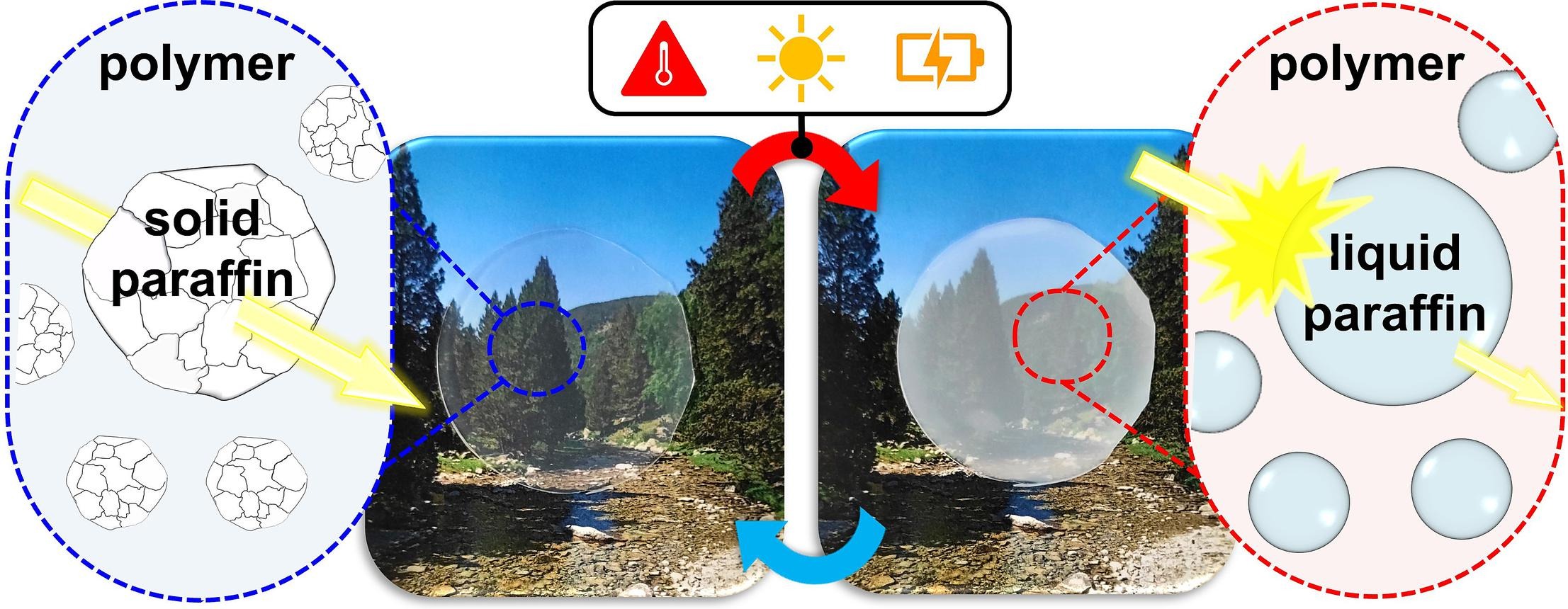Thursday, 30 March 2023
New polymer-paraffin films for smart windows improve responsiveness and scalability
A study published in ‘Chemical Engineering Journal’ and led by researchers from ICN2 and UAB proposes a novel composite material that allows modulating sunlight transmittance in smart windows in response to different stimuli. Being cost-effective, stable, flexible, and scalable, the polymer-paraffin films developed by the authors can help to reduce energy consumption in buildings, among other possible applications.

Smart windows, designed to adapt to the weather conditions and control the amount of sunlight that enters a room, can largely contribute to reducing energy consumption in buildings. They can help to regulate indoor temperature, reduce the need for air conditioning, and provide more comfortable living and working conditions. However, the development of smart windows has been hampered by high costs and technological limitations.
To overcome these problems, researchers at the Catalan Institute of Nanoscience and Nanotechnology (ICN2) and at the Universitat Autònoma de Barcelona (UAB) have developed a new solution based on the use of a composite material made from a transparent polymer matrix in which paraffin nanoparticles are dispersed. This study, carried out by Jaume Otaegui (PhD student at UAB-ICN2) and led by Dr Claudio Roscini, senior researcher in the ICN2 Nanostructured Functional Materials Group, and Dr Jordi Hernando Campos, from the Department of Chemistry of UAB, has been published in the Chemical Engineering Journal.
At room temperature, the nanoparticles incorporated in the polymer are in their solid state, which allows for good matching between the refractive indices of the two components of the material and, therefore, high transparency to visible and near-infrared light. On the contrary, when the paraffin nanoparticles are heated above their melting temperature, their refractive index changes, resulting in increased light scattering at the polymer-particle interfaces and, consequently, pronounced opacity of the material. This change in transparency upon thermal variations is the core of these smart window films able to regulate indoor temperature.
Aside from the capability of modulating sunlight transmittance, these films are also advantageous because they can be easily fabricated from low-cost and readily available materials. They are highly photostable, flexible, and can be easily scaled up, which is a very desired properties for application on large windowed surfaces. In addition, the thermal response of this hybrid material can be fine-tuned by changing the composition of the paraffin nanoparticles.
The authors were also able to obtain a multi-stimuli response, which cannot be achieved with most of the technologies that are currently used in smart glasses. In fact, their polymer-paraffin materials can be adapted to change their transparency not only as a consequence of temperature variations, but also by photoactivation (i.e., light adsorption) thanks to the addition of photothermal agents, or by the application of an external voltage, if deposited onto transparent electrodes. These functionalities would allow smart windows to better respond to the changes of both external temperature and sunlight, as well as to be remotely controlled by a user.
The proposed polymer-paraffin composite films are promising candidate for cost-effective, multi-stimuli, durable and scalable smart glasses, for applications not only in the building industry, but also in other areas such as the automotive industry, greenhouses for horticulture, and ophthalmic applications.
Reference article:
Jaume Ramon Otaegui, Daniel Ruiz-Molina, Jordi Hernando, Claudio Roscini, Multistimuli-responsive smart windows based on paraffin-polymer composites. Chemical Engineering Journal, Volume 463, 2023, 142390. DOI: 10.1016/j.cej.2023.142390

